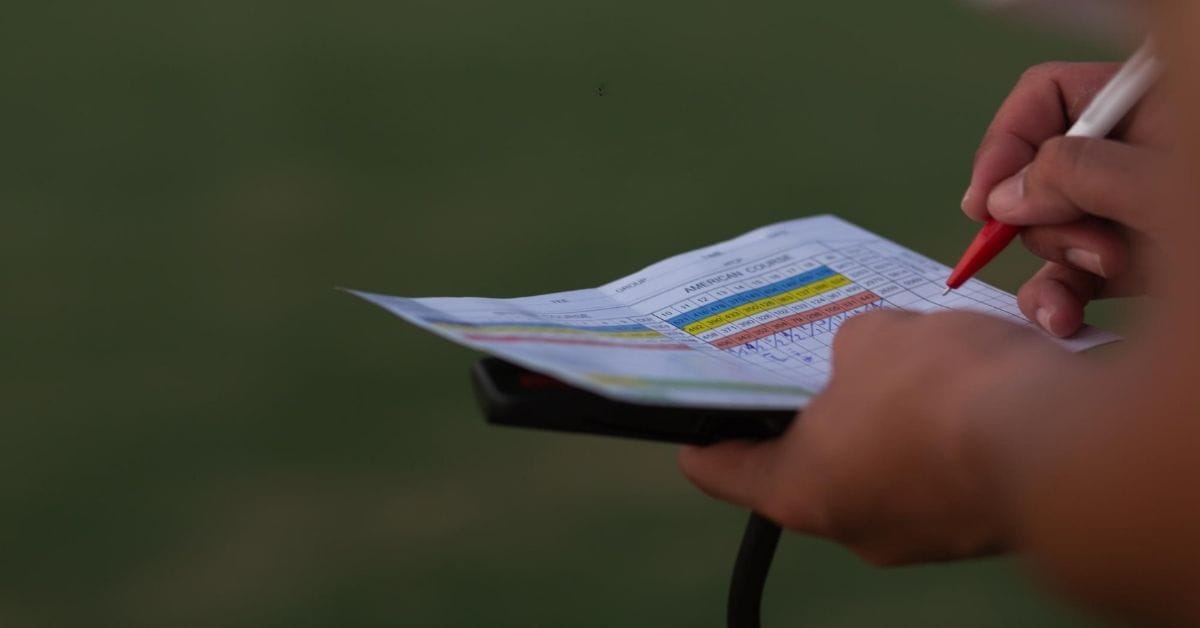
Golf is a game of precision, patience, and strategy. At the heart of it lies the humble scorecard—a small yet powerful tool that records your performance on the course.
Whether you’re a beginner or a seasoned player, understanding golf scorecard symbols is key to improving your game.
These symbols help track your progress, analyze your performance, and identify areas to focus on.
In this guide, we’ll break down the essentials of golf scorecards, including their symbols, uses, and tips to make the most out of them.
Let’s tee off and explore the world of golf scorecard symbols.
Key Takeaways
- Decoding symbols help in identifying birdies, bogeys, eagles, and other key performance metrics.
- Performance insights like GIR (Greens in Regulation) and FIR (Fairway Hits) reveal gameplay patterns.
- Reviewing symbols and scores consistently identifies strengths and weaknesses for strategy refinement.
Table of Contents
What is a Golf Scorecard?
A golf scorecard is more than just a record of scores; it’s a roadmap for your round. It details the layout of the course, including the par for each hole, and provides spaces to log your performance. Modern scorecards even include columns for handicaps, yardages, and sometimes weather conditions.
If you’re curious about what constitutes a good score, especially for beginners, explore What Is a Good Golf Score for 9 Holes for helpful benchmarks.
Scorecards have been part of golf since the 19th century, serving as both a scorekeeping tool and a way to analyze performance. Keeping an accurate scorecard respects the game’s integrity and helps you track improvement over time.
The Anatomy of a Golf Scorecard
To effectively use a scorecard, you need to understand its components. Most scorecards include the following elements:
- Player Names: Spaces to record each player’s name.
- Hole Numbers: A sequence of holes, usually from 1 to 18.
- Par Values: The expected number of strokes to complete each hole.
- Handicap (HDCP) Ratings: A ranking of each hole’s difficulty, with 1 being the hardest and 18 the easiest.
- Score Columns: These are where players record their actual scores for each hole.
A typical scorecard might also feature diagrams of the course layout, yardage from different tees, and notes about hazards or special rules.
Forecaddies and caddies also play a significant role in helping record scores accurately. Learn more about their contributions in Forecaddie vs Caddie: Which One Is Best for You?
Complete List of Golf Scorecard Symbols
Here is a more comprehensive list of symbols that golfers may use:
- Scoring Symbols:
- Birdie (● or 🟩): One stroke under par.
- Eagle (▲ or 🟦): Two strokes under par.
- Albatross/Double Eagle (🟪): Three strokes under par (rare).
- Bogey (● or 🟧): One stroke over par.
- Double Bogey (●● or 🟥): Two strokes over par.
- Triple Bogey (●●● or 🟫): Three strokes over par.
- Penalty and Rule Symbols:
- Penalty Strokes (+1 or P): Indicating additional strokes due to rule infractions.
- Out of Bounds (OB): Marked with an “X” or “O” next to the score for that hole.
- Water Hazard: Often denoted with a “W” or “WH.”
- Unplayable Lie: Sometimes marked with “UL” or a triangle.
- Performance Tracking Symbols:
- Fairway Hit (✓ or F): For hitting the fairway on the tee shot.
- Greens in Regulation (GIR): A checkmark, “G,” or circle for reaching the green in regulation strokes.
- Sand Save (S): Successfully getting out of a bunker and completing the hole in par or better.
- Putts: Numbers (e.g., “2” or “3”) to count the total putts on the green.
- Special Situations:
- Hole-in-One (1 or ⭐): Typically circled for emphasis.
- Pick-Up/Concession: A slash (/) or “PU” indicates the player stopped playing on that hole.
- Mulligan (M): (Informal) Marks a second shot taken unofficially.
- Miscellaneous Symbols:
- Par Save: Circle the score to note a challenging par recovery.
- Chip-In: “C” or asterisk (*) to signify holing a chip directly into the hole.
- Missed Fairway (MF): An “X” or arrow indicating a tee shot missed the fairway.
- Customization: Many golfers personalize their scorecards with unique symbols or notes:
- Arrows: For wind direction or slope of the green.
- Dots: To mark emotional or strategic notes (e.g., a “hard hole”).
- Circles/Squares Around Numbers: Highlighting birdies (circle) or bogeys (square).
How to Use Scorecard Symbols Effectively
Using scorecard symbols isn’t just about recording your scores; it’s a tool for strategic improvement. For team formats like Texas Scramble, precise scorekeeping is even more critical. Explore winning strategies and variations in the Texas Scramble Golf Format.
- Stay Consistent: Use the same symbols across all your games to make comparisons easier.
- Be Accurate: Ensure every stroke is counted, including penalties.
- Review Your Scorecard: After each round, review your scorecard to identify strengths and weaknesses.
- Leverage Technology: Consider apps or digital tools that let you replicate and expand on scorecard symbols.
Frequently Asked Questions
Final Thoughts
Mastering golf scorecard symbols is a key step in improving your game. These symbols are more than just marks; they tell the story of your performance on the course.
By understanding what each symbol means, you can track your progress, identify patterns, and make strategic adjustments. Whether you’re circling a birdie, marking an eagle, or noting penalty strokes, a detailed scorecard offers valuable insights.
Next time you hit the course, take a moment to use these symbols thoughtfully. They’ll not only help you analyze your game but also make every round more engaging and enjoyable. Happy golfing!
